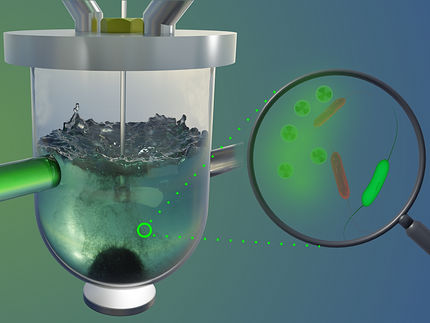Cheap and sustainable cleansing of water from heavy metals
Researchers develop filter systems based on lignin
In order to cleanse wastewater of heavy metals, industry has to resort to highly refined filter technologies. Often, the production of these very technologies is not truly environmentally friendly either. Vienna-based researchers are now developing filter systems based on Lignin, a waste product from the paper industry. Their process promises a small ecological footprint and low production costs.
In recent decades, the quantities of heavy metals discharged into European water bodies from chemical, metallurgical and metal processing plants have decreased drastically. This is due not only to strict EU regulations, but also to highly developed filter technologies that can do a good job extracting lead, zinc, copper and chromium from wastewater. This ability comes at a price, however. The filter materials themselves consist of products from the chemical industry, which are manufactured from petroleum products in extremely complex processes - also in themselves producing hazardous wastewater.
In the context of the FWF-funded project “Bio-based macroporous materials for heavy metal absorption”, Alexander Bismarck, Hande Barkan and Philip Verdross and their group of researchers at the University of Vienna are exploring a promising alternative. Inexpensive, bio-based raw materials and industrial by-products are forged into a permeable polymer structure with a pore structure that can be specifically adapted to bind and accumulate heavy metals. The method is designed to reduce the ecological footprint of the filters by a factor of multiples. For this cross-border project, the University of Vienna has joined forces with the Luxemburg Institute of Science and Technology.
“In this project, we focused on the adsorption of toxic chromium. Chromium VI is used inter alia for tanning leather. Particularly in Southeast Asia, this heavy metal often is discharged into rivers unfiltered,” notes chemist Hande Barkan. “We need new technologies that are both sustainable and cheap in order to improve the situation.” Moreover, the technology studied is also of interest for the removal of copper, lead, arsenic and mercury.
Filter systems made from renewable raw materials hold great potential for the industry. Not only are they many times cheaper and more environmentally friendly to produce, they are also more efficient. Some heavy metals still find their way into rivers unfiltered.
A by-product from the paper industry
The innovative materials are based on lignin, i.e. the material that provides stability to the cell walls of plants. Cellulose production in the paper industry produces a by-product called black liquor, which contains a great deal of lignin in addition to residues from the extraction chemicals used. This black liquor serves as a propitious base material for the researchers. Other materials they use are agricultural by-products, such as vegetable fats or glycerine, which is produced from bio-based raw materials. Amine carbon compounds are an exception, as they are produced industrially as petroleum products. “Amines are used as so-called crosslinkers and they are responsible both for the crosslinking of the natural substance molecules and, later, for the chemical bonding of the heavy metals to the polymers,” explains Barkan. In overall terms, however, the bio-based materials, especially lignin as the “main ingredient”, have an extremely positive effect on the life cycle analysis of the development, notes Barkan.
This being said, it takes more than creating a functional, solid material from the natural substance lignin. The resulting polymer structure, in which many complex macromolecules are intertwined, requires a pore structure that maximizes the separation of heavy metals from the water sent through the structure. The technology able to do that is called “foam/emulsion templating” and was significantly co-developed by Bismarck and his team.
From droplet to filter pore
As the name suggests, the shape of the polymer is fixed in an emulsion. “A large number of droplets is dispersed in this foam-like liquid. The size and frequency of the droplets is determined by surfactants that are added according to specific criteria. Surfactants are substances that influence the interfacial tension between liquids,” explains Philip Verdross. “The emulsion and the liquid polymer are mixed before the polymer is cured. The emulsion then acts as a template that determines the shape and pore properties of the lignin-based plastic. Where there were droplets in the emulsion, there are pores in the finished polymer.”
“The adsorption of Chromium VI with this technology offers a great advantage, because the heavy metal is not only bound to the amines, but also undergoes a further reaction,” notes Verdross. The highly toxic and carcinogenic Chromium VI is converted into the harmless Chromium III – a step that would require a separate process with conventional methods. For other heavy metals, the separation as such would work similarly to the way it works with chromium. The researchers hope that the use of renewable raw materials will enable low-cost industrial production. If the approach can actually be used on a large scale, it could achieve a substantial reduction in heavy metal pollution in river courses worldwide.
Original publication
Philip Verdross, Robert T. Woodward, Alexander Bismarck; "Flexing with lignin: lignin-based elastomers synthesised from untreated kraft black liquor"; Polymer Chemistry, Volume 15, 2024
Hande Barkan-Öztürk, Philip Verdross, Alexander Bismarck; "Macroporous lignin adsorbents: A bio-sourced tool kit to defuse the Cr(VI) threat in wastewater"; Journal of Environmental Chemical Engineering, Volume 12
Khatanbaatar Byambatsogt, Qixiang Jiang, Aayush Kumar Jaiswal, Vesa Kunnari, Alexander Bismarck, Andreas Mautner; "Pilot-scale foam and cast-coated nanocellulose filters for water treatment"; Monatshefte für Chemie - Chemical Monthly, 2024-5-17
































































